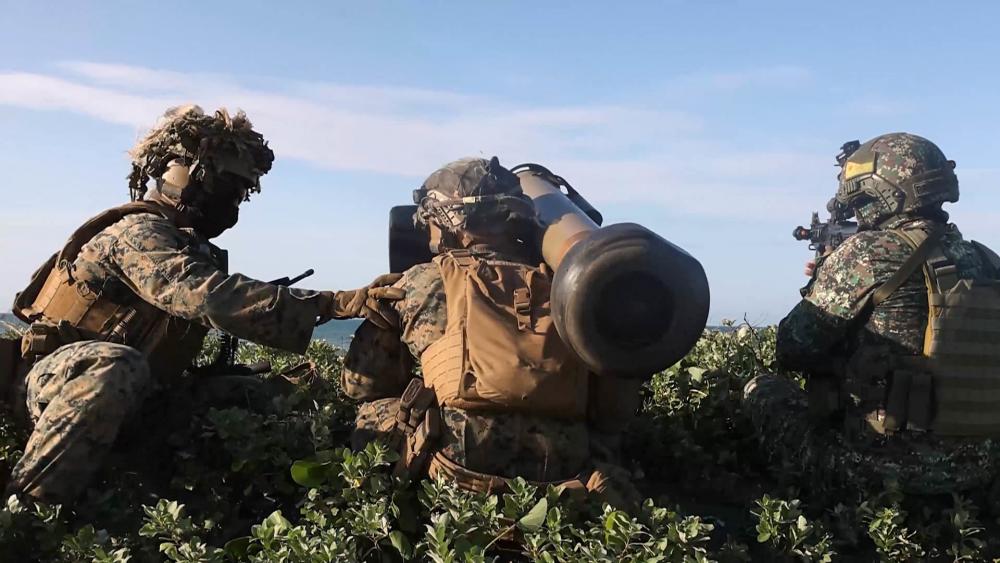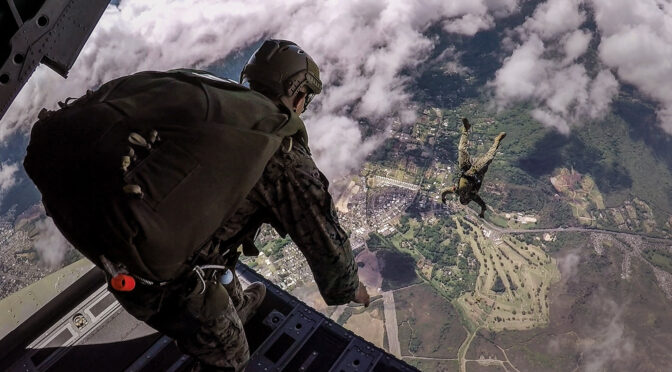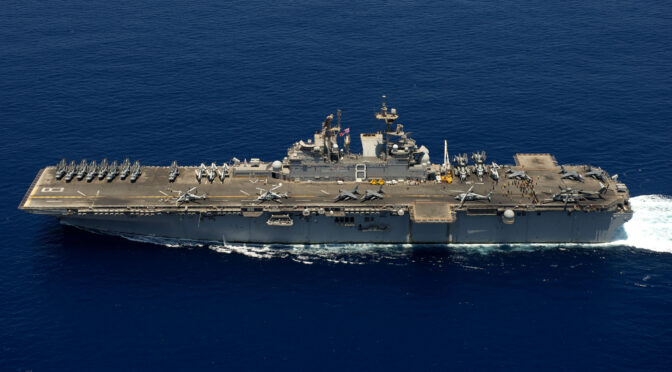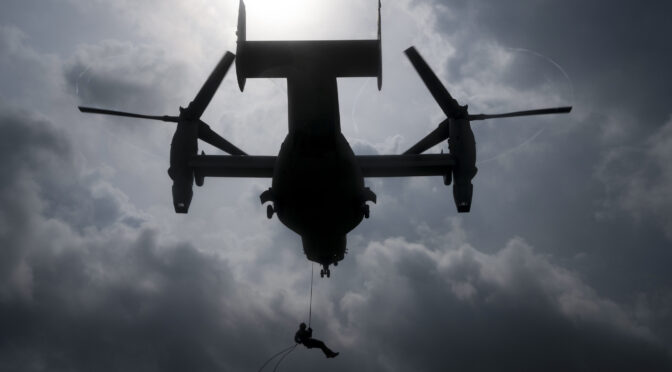Transforming the Marine Corps Topic Week
By Majors Zach Ota and Eric Hovey, USMC
Introduction
The past few months have seen renewed interest and controversy surrounding the 38th Commandant’s Force Design 2030 efforts to modernize the Marine Corps and meet the demands of the National Defense Strategy. Though initial feedback to Force Design 2030 was largely positive, an increasingly vocal subset of retired general officers and senior civilians have publicly sounded the alarm that the divestments and doctrinal changes espoused by General Berger, such as Expeditionary Advanced Base Operations (EABO) and stand-in forces, go too far and risk irreparably harming the Marine Corps.1 Nearly three years after the publication of the 38th Commandant’s Planning Guidance, the Marines find themselves at an uncomfortable crossroads: retired senior leaders decrying what they see as destructive changes, and active duty leaders defending the methodology undergirding the Marine Corps’ transformation.2
The purpose of this article is to shift the debate from litigating the merits of EABO, Force Design 2030, and its accompanying Stand-in Forces (SIFs) concept, to improving their efficacy by addressing known shortfalls. Modifying these concepts is a better approach than rejecting them wholesale for two reasons: first, they were implemented with the understanding that incremental updates would be necessary and two, many of the recent arguments against Force Design 2030 are weak and do not hold up under scrutiny. LtGen (ret) Van Riper’s critiques about the divestiture of tanks never explains how a future USMC could employ these logistically intensive armor systems to deter China in a future conflict.3 Gen (ret) Terry Dake writes an entire article bemoaning cuts to the Marine’s Air Combat Element (ACE), while not once mentioning the significant (and necessary) increases to the Corps’ unmanned aviation capabilities.4 It is impossible to ignore the criticisms of these retired senior leaders, but it is equally important to not let their concerns derail the necessary organizational changes implemented under General Berger. This article therefore rejects the notion that the USMC should stop or reverse Force Design 2030, and instead focuses on providing the critical feedback and ideas necessary to make it a success.5
A key challenge facing the current and future Marine Corps is gaining and maintaining access. After framing the central role that access challenges will play in implementing Force Design 2030 and its associated warfighting concepts, recommendations are then proposed for how the USMC can best employ its cadre of international affairs (IA) Marines to address this access challenge. The desired endstate is thus to improve these concepts to ensure that their implementation is successful in deterring and, if necessary, defeating America’s enemies. Force Design 2030 is the future of the Marine Corps – IA Marines are ready to make it a reality.
Framing the Problem – Access
The biggest potential flaw in the USMC’s Force Design 2030 is the access challenges U.S. military forces will face in the event of direct conventional conflict with Russia or China. For brevity, this article focuses on the most pressing scenario of conflict with China. Simply put, any USMC effort to deter and defeat China within the USINDOPACOM area of responsibility requires Marines to have access to the air, land, and territorial seas of a foreign partner, but the Marine Corps currently lacks an international affairs operating concept to ensure that this access is granted.6
Focusing on access is critical because, by definition, EABO and its associated Stand-in Forces concept cannot exist without the support of partners and allies. Expeditionary advanced bases and forward terrain of interest within an adversary’s weapons engagement zone will mostly be on the territories of allies and partners. The May 2022 Force Design 2030 update notes that, “access and placement matter” for our warfighting concepts and capabilities. As envisioned in A Concept for Stand-in Forces, stand-in forces are the means and ways to “set conditions for the introduction of naval and joint forces.”7 Stand-in forces critically require an understanding of allies, partners, and their operating environments to succeed as a joint access enabler. It is much more preferable to gain access to allied and partner territories in peacetime through constructive engagement than to have to secure access through warfighting in the midst of conflict.
To operationalize the Stand-in Forces concept, the Marine Corps must look beyond just the systems and technologies which these forces may field. Political and diplomatic access is a critical enabler for these forces to be positioned on territory of interest. While the USMC is pushing hard to develop new technologies, these capabilities may be for naught if Marines do not have the basing and access required to not only get to the fight, but to be on the fight’s frontlines as stand-in forces in the critical first days and weeks of a crisis. There are convincing arguments as to why the USMC needs more unmanned aviation over traditional manned platforms, more long-range rocket artillery over traditional gun systems, but the lack of detail in how USMC forces will be able to achieve physical and diplomatic access prior to conflict is problematic.8
The origins of this gap are understandable: USMC planners had to move quickly and make some assumptions in the earliest days of Force Design 2030 in order to validate warfighting concepts and make informed decisions about changes to force structure. Nearly three years on, however, and in a world where China’s global naval ambitions are becoming increasingly assertive, the USMC cannot afford to assume or underinvest in building strong relations with partners and allies to ensure access.9
International Affairs Marines – Key Enablers to Support USMC Access
IA Marines come from various backgrounds and are comprised primarily of foreign area officers (FAOs), regional area officers (RAOs), and foreign area staff non-commissioned officers (FASs).10 The International Affairs Program of Headquarters Marine Corps describes FAOs as such: “FAOs develop professional language regional expertise and cultural (LREC) capabilities and insights to help MAGTF, Joint, and Coalition commanders understand the complex human environment where Marines deploy.” FAOs bring to the MAGTF their unique capabilities in regionally-focused graduate education, foreign language proficiency, and personal experience through regional travel and immersion. Similarly, RAOs “develop specialized regional expertise through graduate education or significant time abroad” and inform commanders on the operational environment. FASs “apply LREC to the Marine Corps Planning Process, Security Cooperation and combined exercise planning, and serve as LREC trainers for operational force units, members of Forward Command Elements, and inter-organizational liaisons.” Together, these IA Marines form a multi-functional cadre of foreign area experts who fulfill an array of billets in the interagency, joint, and Fleet Marine Force.
IA Marines are critical enablers for the Marine Corps capabilities envisioned in Force Design 2030 and concepts for EABO and SIFs. Across the levels of war and through the spectrum of competition to conflict, IA Marines develop an understanding of the operational environment, develop capabilities in allied and partnered forces, gain and maintain access to key terrain, and enable the introduction and employment of U.S. forces. International Affairs Marines are arguably the Marine Corps’ first stand-in force – and set conditions so that, in the run-up from competition to conflict, Marines can have the access, basing, and overflight to execute the Marine Corps’ warfighting concepts.
Strategically and globally, IA Marines gain and maintain access, influence, and develop capabilities for larger stand-in forces. IA Marines are the critical touchpoints with both the U.S. Department of State and foreign militaries, ensuring mutual understanding of USMC capabilities and advocating for access. IA Marines are therefore critically positioned to advocate for Force Design 2030 and stand-in forces to allied and partner governments. As members of embassy country teams, IA Marines are highly capable, low-signature enablers of U.S. access. In 34 countries around the world, including Taiwan, Ukraine, and Iraq, IA Marines serve as attachés, advising U.S. ambassadors and advancing U.S. national and foreign security policies, including the specified interests of the Navy and Marine Corps.11 Additionally, through security cooperation and security assistance, IA Marines facilitate the development of critical capabilities with allies and partners, such as the Harpoon Coastal Defense System. IA Marines in embassies around the world inform MAGTF commanders of the operational environment and set the conditions for the introduction of larger forces.
At the operational level, IA Marines translate strategic objectives into tangible ways and means through security cooperation, security assistance, and campaigning with allies and partners. IA Marines leverage their operational experience and focused understanding of the operational environment to align resources and inform commanders. While ultimate approval of formal bilateral agreements lies at higher level of State and OSD policymaking, FAOs and RAOs are the immediate connective tissue linking U.S. military forces with their counterparts abroad. Thus, anytime one reads an impactful bilateral security document—such as the historic defense cooperation roadmap signed between the U.S. and Morocco in 2020—FAOs at the country-team level were heavily involved in the process.12 Aligning USMC FAOs and RAOs toward the USINDOPACOM access problem set is therefore essential to ensure the political and military viability of stand-in forces.

At the tactical level, IA Marines enable the introduction and inform the employment of USMC capabilities alongside allies and partners during competition, crisis, and conflict. Not only can the Marines help impart wisdom about amphibious operations, but our regional partners and allies can teach us skills and share technologies too. Indeed, Colonel Yusuke Kawachi, a Japanese military attaché to the United States, noted that Japanese Ground Self-Defense Forces have been using land-based anti-ship missiles analogous to the USMC’s nascent ROGUE fires system since the Cold War.13 Similarly, not only are the U.S. Navy and USMC pursuing LAW development, but the Australian Army is also investing hundreds of millions of dollars in improving their own littoral vessel capabilities.14 Recognizing and taking advantage of this aspect of the operating environment offers great opportunities, especially “when each ally and partner makes the best use of their respective comparative advantages.”15
International Affairs Marines – Challenges and Way Ahead
The requirement for highly trained, multi-functional international affairs experts has never been greater. Additionally, forces with light footprints increase their chance of survival in contested spaces. As A Concept for Stand-in Forces emphasizes, “reducing the number of Marines needed to operate effectively means each Marine must have the ability to perform an expanded set of tasks when compared to current practice.” IA Marines are the low-signature, persistently postured intermediaries with our allies and partners that enable USMC warfighting concepts.
Force Design 2030-related budgetary decisions are jeopardizing the high-demand, low density International Affairs Program, however. Although the deactivation of the Marine Corps Security Cooperation Group created the potential to reinvest existing structure in the Fleet Marine Force, those billets were instead recapitalized for other purposes. The recently created information maneuver military occupation specialty (MOS) is a positive example of Force Design 2030-related structure reinvestments, but these new influence-related specialties lack the education and experience working alongside our allies and partners to be effective in their operating environment.
Additionally, the remaining structure for International Affairs Marines is not optimized to achieve the objectives of Force Design 2030, the Stand in Forces concept, or EABO. IA Marines are not deliberately organized into the Fleet Marine Force, and successive duty assignments often squander the accumulated knowledge and capabilities of IA Marines. Indeed, of the 14 Marines who were selected to be FAOs in the 2016 Commandant’s Career Level Education Board (CCLEB), and thus forecasted for a summer utilization tour slating, only four were able to be utilized.16 The requirement for Marine Corps FAOs to conduct a tour in their primary MOS immediately after completion of their training pipeline (to remain competitive for promotion in their original community) is the proximate cause for this talent management disconnect.
Generating an international affairs operating concept would be one way that the USMC could prioritize and execute the necessary changes to align IA Marines to the access challenges inherent within Force Design 2030. A critical first step toward realizing this operating concept would be to stop the misallocation of study-track FAOs, as seen with the ongoing challenges to slate utilization tours for CCLEB Marines. The Marine Corps can and should move quickly to generate a primary MOS for IA Marines, just as the organization addressed comparable talent management issues in the past by creating the 8059/61 acquisitions community and the recent 1700 information maneuver community. This is not a new idea, and a low-density, lateral-transfer community for IA Marines would allow the organization to grow and operationalize its resident IA experts, especially as concerns USINDOPACOM.17 Moreover, optimizing the organization, promotion, and retention of IA Marines would fall squarely within the guidance of the FY22 National Defense Authorization Act, and the best practices of the Army, Navy, and Air Force, which all have PMOSs for FAOs.18
With these immediate manpower challenges addressed, an international affairs operating concept would enable Fleet Marine forces by aligning IA Marines to impactful assignments where they can advocate for the Marine Corps, from access issues to building and sustaining relationships with partners and allies. Under this new concept, IA Marines could also potentially retain their original MOS as a secondary MOS to employ their expertise in designated Fleet Marine Force billets that require a fusion of these two skills. For example, a Mandarin-speaking FAO with a secondary specialty of intelligence would be qualified to serve as the III Marine Expeditionary Force Assistant Chief of Staff for Intelligence. The underlying theme of a proposed international affairs concept is that IA Marines must be deliberately leveraged for their critical capabilities.
Conclusion
The service must recognize that new concepts and capabilities critically require the political, diplomatic, cultural, and historic understanding of the operating environment that IA Marines uniquely contribute. It is one thing to have a bilateral exercise, such as a KMEP with our Korean allies on the peninsula, but when that exercise is paired with a Korean-speaking FAO or LNO who can help bridge the gap between tactical-level staffs and speak to emerging USMC doctrine in Korean, the value added is immense. We would not expect another service or agency to advocate to Capitol Hill on our behalf; so too must we not outsource Marine Corps access and influence on key forward terrain. The capabilities delivered by IA Marines are critical to our continued effectiveness as a fighting force.
Ultimately, investing in the USMC IA community is about investing in the success of EABO and the larger FD 2030 effort to focus on strategic competition against peer competitors, like China. It means acknowledging that campaigns will not occur on amorphous blobs devoid of people; they will occur on key terrain with diverse populations and differing predilections. Fortunately, we know where this key terrain is and, in most cases, the populations and governments are friends. In a combined campaign, our allies and partners will be the primary stand-in force. In this dynamic, IA Marines are key enablers for combined stand-in forces.
History tells us that navigating concerns of national pride and sovereignty are complex, and that even a perceived common enemy is no guarantee of harmony amongst allies. During the WWII Pacific campaign, for example, the U.S. Navy’s official history wryly noted that both French and British civilians hoped U.S. forces would serve as a check against the other.19 Given the recent diplomatic row between the U.S., UK, Australia, and France over an Anglophone military and technology pact dubbed AUKUS, military planners must always be cognizant of the potential for friction with allies and work continuously to ensure smooth communication.20 As Winston Churchill stated, “there is only one thing worse than fighting with allies, and that is fighting without them!”21 IA Marines can help the USMC navigate the sensitivities of allies that have critical operational implications.
The current tech-centric debates about the merits of Force Design 2030 miss the mark because they do not address the most important subject: people. Deterring and defeating China is not simply a matter of developing new technology, it is about the United States maintaining access and strong relationships with partners and allies. Alliances and partnerships are America’s greatest strategic asset, and a robust cadre of IA Marines is therefore essential to the successful implementation of Force Design 2030 and the continued relevance of the Marine Corps.22
Zach Ota is a Marine infantry officer and Southeast Asia regional area officer. He deployed in support of Operation Iraqi Freedom, the 31st Marine Expeditionary Unit, Operation Enduring Freedom, and the Unit Deployment Program. He currently serves in the International Affairs Branch, Plans Division, U.S. Marine Corps Forces, Pacific. He can be found on Twitter at @zach_ota.
Eric Hovey is a Marine foreign area officer and member of the Foreign Area Officer Association (FAOA) Board of Governors. He is currently based in Washington, DC and can be found on Twitter at @Eric_Hovey.
The views expressed in this article are presented in a personal capacity and do not necessarily reflect the views of the U.S. Marine Corps or other U.S. government institutions.
References
[1] Paul McLeary and Lee Hudson, “How Two Dozen Retired Generals Are Trying to Stop an Overhaul of the Marines,” Politico, 1 April 2022, https://www.politico.com/news/2022/04/01/corps-detat-how-two-dozen-retired-generals-are-trying-to-stop-an-overhaul-of-the-marines-00022446.
[2] “A Critical Discussion on Force Design 2030 with LtGen Paul Van Riper and Gen Anthony Zinni,” The Warfighting Society, April 14, 2021, https://www.youtube.com/watch?v=fL-yFiveCag
[3] P. K. Van Riper, “The Marine Corps’ Plan to Redesign the Force Will Only End Up Breaking It,” Task and Purpose, 20 April, 2022, https://taskandpurpose.com/opinion/marine-corps-force-design-infantry/.
[4] Terry Dake, “The Marine Corps’ Reorganization Plan Will Cripple Its Aviation Capabilities,” Task and Purpose, 22 April 2022, https://taskandpurpose.com/opinion/force-design-2030-cripple-marine-aviation/.
[5] Dake, “The Marine Corps’ Reorganization Plan Will Cripple Its Aviation Capabilities,” pg. 23.
[6] George J. David, “Making it Work,” vol. 104, no. 10, Marine Corps Gazette (October 2020): 46.
[7] “A Concept for Stand-in Forces,” Headquarters Marine Corps, December 2021, https://www.hqmc.marines.mil/Portals/142/Users/183/35/4535/211201_A%20Concept%20for%20Stand-In%20Forces.pdf?ver=MFOzu2hs_IWHZlsOAkfZsQ%3D%3D.
[8] The Warfighting Society, “A Critical Discussion on Force Design 2030 with LtGen Paul Van Riper and Gen Anthony Zinni.”
[9] Damien Cave, “Why a Chinese Security Deal in the Pacific Could Ripple Through the World,” The New York Times, April 20, 2022, https://www.nytimes.com/2022/04/20/world/australia/china-solomon-islands-security-pact.html; David Vergun, “General Says China Is Seeking a Naval Base in West Africa,” Department of Defense, March 17, 2022, https://www.defense.gov/News/News-Stories/Article/Article/2969935/general-says-china-is-seeking-a-naval-base-in-west-africa/.
[10] This definition of IA Marines implicitly includes other programs such as Marine Attachés and international Personnel Exchange Program (PEP), since these Marines can subsequently apply for FAO/RAO accreditation after their tours, if they were not already accredited to begin with.
[11] “Marine Corps Support to the Defense Attaché Service (DAS),” Headquarters Marine Corps, https://www.hqmc.marines.mil/intelligence/Intel-OPS-PERS/Defense-Attache-Program/.
[12]Jim Garamone, “U.S., Morocco Chart Defense Cooperation Through 2030,” Department of Defense, October 2, 2020, https://www.defense.gov/News/News-Stories/Article/Article/2369742/us-morocco-chart-defense-cooperation-through-2030/.
[13] Yusuke Kawachi, “Opportunities and Challenges,” vol. 106, no. 5, Marine Corps Gazette (May 2022): 39.
[14] “Austal Australia to Bid for New Littoral Manoeuvre Capability for the Australian Army,” Austal Limited, May 31, 2022, https://www.austal.com/news/austal-australia-bid-new-littoral-manoeuvre-capability-australian-army.
[15] Headquarters Marine Corps, “A Concept for Stand-in Forces.”
[16] “International Affairs Program Newsletter,” Headquarters Marine Corps, Second Quarter 2022, https://www.hqmc.marines.mil/Portals/138/Users/039/23/3623/2022-Q2_IAP_Newsletter_4-25-2022_FINAL.pdf?ver=hu5priT0udURXM66BpUM3Q%3d%3d.
[17] William B. Easter, “FAOs and RAOs: We Need to Better Manage These Skills More Effectively,” vol. 104, no. 1 Marine Corps Gazette (January 2020): 77-78.
[18] U. S. House of Representatives, “Rules Committee Print 117-21 Text of House Amendment to S. 1605,” December 7, 2021, https://rules.house.gov/sites/democrats.rules.house.gov/files/BILLS-117S1605-RCP117-21.pdf#page=1186.
[19] James D. Hornfischer, Neptune’s Inferno: The U.S. Navy at Guadalcanal, (United States: Bantam; 2012), page 38.
[20] Heather A. Conley and Michael J. Green, “Don’t Underestimate the AUKUS Rift With France,” Foreign Policy, September 22, 2021, https://foreignpolicy.com/2021/09/22/aukus-france-biden-europe-allies/.
[21] Kenneth Harris, “Wartime Lies,” The New York Times, last modified April 27, 1997, https://archive.nytimes.com/www.nytimes.com/books/97/04/27/reviews/970427.27harrist.html?scp=80&sq=cross%2520word&st=cse.
[22] Joseph R. Biden, Jr., Interim National Security Strategic Guidance (Washington, DC: White House, 2021), 10, https://www.whitehouse.gov/wp-content/uploads/2021/03/NSC-1v2.pdf.
Featured Image: Marines with the Maritime Raid Force, 11th Marine Expeditionary Unit, conduct military free-fall training over Marine Corps Training Area Bellows, Oahu, Hawaii, as part of the 11th MEU’s Western Pacific 16-2 deployment, Oct. 18, 2016. (U.S. Marine Corps photo by Lance Cpl. Devan K. Gowans)



